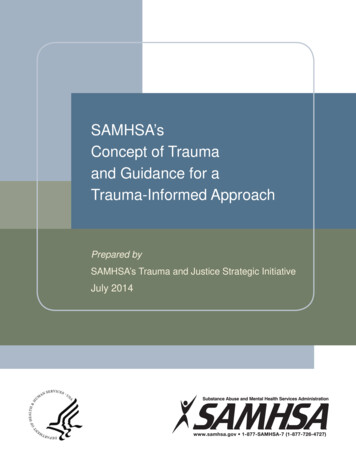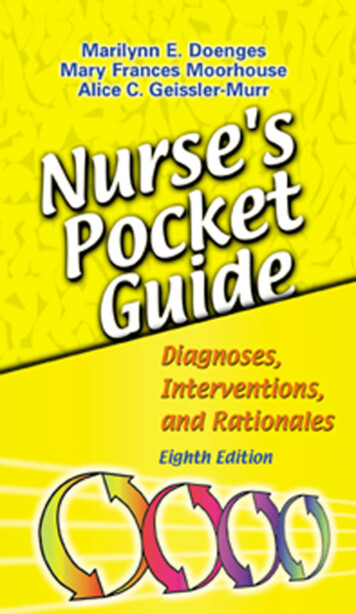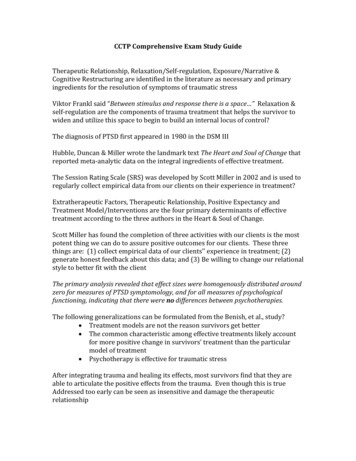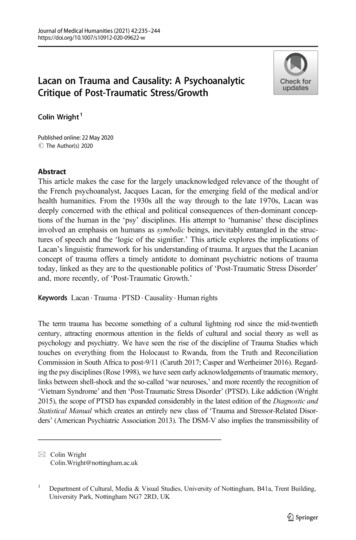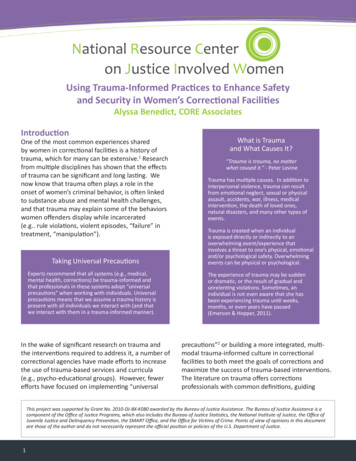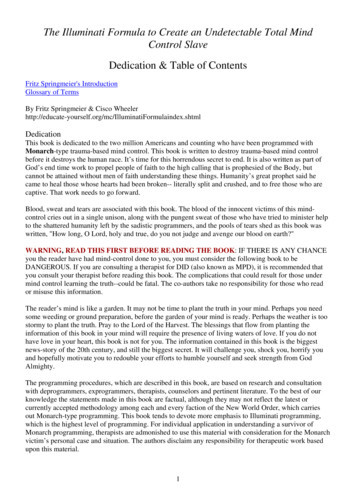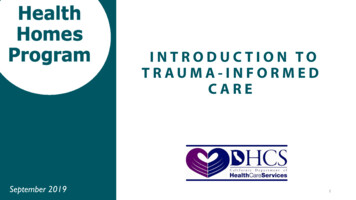
Transcription
INTRODUCTION TOTRAUMA-INFORMEDCARESeptember 20191
TRAINING PURPOSE Provide basic information to health plan and community-based caremanagement entity (CB-CME) staff on trauma-informed care and directthem to resources for additional information The Department of Health Care Services (DHCS) recommends that allstaff supporting Health Homes Program (HHP) members receivetraining on trauma-informed care (Program Guide Appendix C) All communication with members must utilize trauma-informed carepractices (Program Guide Section VI)2
WHAT IS TRAUMA?“Individual trauma results from an event, series of events, or setof circumstances that is experienced by an individual asphysically or emotionally harmful or life threatening and that haslasting adverse effects on the individual’s functioning and mental,physical, social, emotional, or spiritual well-being.”Source: Substance Abuse and Mental Health Services Administration (SAMHSA) 3
WHAT IS TRAUMA?Trauma is relativePerception and response to trauma varies by individualTrauma is cumulativeTraumatic experiences can be isolatedevents or can be compounded byrepetitive trauma throughout a lifetimeTrauma is complexExposure to trauma and an individual’sresponses to it are complex and relatedto physical, social, and cultural factors4
WHAT IS TRAUMA-INFORMED CARE?“An organizational structure and treatment frameworkthat involves understanding, recognizing andresponding to the effects of all kinds of trauma.”Source: Traumainformedcare.orgWhat is Trauma-Informed Care? Video5
HOW TRAUMA-INFORMED CAREFITS INTO THE HHP All staff that provide HHP services should be trained in recognizingtrauma and providing trauma-informed care These staff include, but are not limited to:– Care Coordinators– HHP Directors– Clinical Consultants– Housing Navigators– Community health workers6
HOW TRAUMA-INFORMED CAREFITS INTO THE HHPTrauma-informed care should be providedto members through all HHP services: Assessment Health Action Plan development Health Action Plan implementation Care Coordinator, community healthworker, and other care team interactionsand communication with members7
WHAT IS THE IMPACT OF TRAUMA? Trauma is prevalent Early trauma has long-termconsequences Trauma complicates chronic diseasemanagement Trauma complicates behavioralhealth treatment Trauma and homelessness are oftencorrelated8
ADVERSE CHILDHOOD EXPERIENCESAdverse Childhood Experiences (ACEs) impact physical and psychologicaldevelopment: ACEs change brain and immune system function and can lead to detrimentalphysical and mental health effects decades in the future There is evidence that ACEs impact genetics, leading to intergenerationaleffects of exposure to trauma In California, 63.5% of adults report exposure to adverse childhoodexperiences* If a child experiences one ACE, there is an 85% chance of experiencing twoor more ACEs* Source: Let’s Get Healthy California 2015 DataSource: ACEs 101 Fact Sheet9
ADVERSE CHILDHOODEXPERIENCES RESEARCHOriginal Study - Felitti VJ, Anda RF, et al.Relationship of childhood abuse and household dysfunction to many of theleading causes of death in adults: The Adverse Childhood Experiences (ACE)Study. American Journal of Preventive Medicine 1998;14:245-258Hundreds of research articles since then have confirmed and expanded on thefindingsSAMHSA Short Video on ACEs10
ACES AND CHRONIC DISEASEResearch shows that ACEs lead to chronic disease, such as: Emphysema Chronic bronchitis Autoimmune disease Diabetes Obesity Heart disease Stroke Cancer11
ACES AND BEHAVIORAL HEALTHResearch shows that ACEs lead to higher risk of: Smoking Alcoholism Drug use Suicide attempts Depression Risky sexual behavior and STDs12
ADULT TRAUMA Chronic stress and trauma exposure have the most significant impact onphysical and mental health Single traumatic events can have harmful physical and psychological effects Nearly all body systems are negatively affected by trauma:– Gastrointestinal function– Cardiovascular system– Immune system– Reproductive system– Musculoskeletal system– Neuroendocrine function– Brain functionSource: D’Andrea W, Sharma R, et al. 2011.Physical Health Problems After Single TraumaExposure:When Stress Takes Root in the Body13
COMMUNITY TRAUMA Trauma can manifest at an individual orcommunity level Communities experiencing high levels ofviolence, poverty, lack of infrastructure, andoppression can experience collectivetrauma in addition to personal trauma14
COMMUNITY TRAUMA Collective trauma compounds the effects of individual trauma Community trauma and violence impacts the social environment, communityengagement and cultural norms Community trauma can be related to the physical/built environmentincluding unsafe housing, lack of transportation, community displacement, orlack of opportunities for physical activity Community trauma can be highly correlated with economic factors such aspoverty and inequity15
MITIGATING THE EFFECTS OF TRAUMA Neurological effects of trauma can be modified Interactions with people who provide support and encouragement cancounter the harmful effects of trauma Identification and intervention are key Health care providers can mitigate the effects of trauma by:– Implementing trauma-informed communications– Identifying exposure to trauma– Providing appropriate resources and referrals16
SAMHSA’S 4 R’SOF TRAUMA-INFORMED CAREA trauma-informed program, organization or system: Realizes the impacts of trauma and the need for trauma-informed care; Recognizes the signs and symptoms of trauma; Responds by incorporating trauma-informed practices throughout thesystem; and Resists re-traumatizationSource: SAMHSA’s Concept of Trauma and Guidance for a TraumaInformed Approach, 2014.17
SAMHSA PRINCIPLES OFTRAUMA-INFORMED PRACTICE1.2.3.4.5.6.SafetyTrust and transparencyPeer support and self helpCollaboration and mutualityEmpowerment, voice, and choiceCultural, historical, and gender issues18
WHAT DOES TRAUMA-INFORMEDCARE LOOK LIKE IN PRACTICE?SafetyTraditional approach: A 25-year-old patient who has experienced sexual traumaavoids appointments for her annual women’s physical, which she knows will includea pelvic exam. Health center staff are concerned with scheduling and productivity.Interactions between patient and staff focus on the patient’s history of missedappointments and late cancellations.Trauma-informed approach: When making appointments that will involvepotentially triggering services, such as pelvic exams, a few simple questions areadded to the phone script. Do you have a preference for a male or female provider?Is there anything we need to know to make your exam more comfortable for you?In this scenario, health center staff are signaling to the patient that she will be entering asafe environment and that staff and providers want to help her feel comfortable.19
WHAT DOES TRAUMA-INFORMEDCARE LOOK LIKE IN PRACTICE?Trust and TransparencyTraditional approach: A 35-year-old patient was sexually abused as a child andhas never disclosed the events to anyone. He is offered a telehealth consult with apsychologist to discuss his anxiety and depression.The health center believes thiswill increase access to care.The patient is hesitant because he is concerned aboutprivacy and believes someone may walk in the room in the provider’s officewithout his knowledge. He declines the consult and forgoes a behavioral healthconsult until months in the future when an in-person appointment can be made.20
WHAT DOES TRAUMA-INFORMEDCARE LOOK LIKE IN PRACTICE?Trust and Transparency (continued)Trauma-informed approach: The patient is given a short handout abouttelehealth psychology consults, which addresses frequently asked questions aboutconfidentiality and logistics. He is given an opportunity to speak directly with thebehavioral health department before committing to an appointment.In this scenario, the health center staff are transparent about what the patient can expectduring the consult and build trust by offering him an opportunity to reassure himself aboutthe process.21
WHAT DOES TRAUMA-INFORMEDCARE LOOK LIKE IN PRACTICE?Peer Support and Self-HelpTraditional approach: A 50-year-old diabetic patient sees his provider onceevery 3 months and has the same conversation every time.The patient pretends tobe following his diet and exercise routine because he doesn’t want to beadmonished.The patient grew up in an emotionally abusive household and still hasa difficult time dealing with authority figures.Trauma-informed approach: The patient is invited to be part of a diabeteseducation and support group where he interacts with other patients, learns somecooking and healthy living skills and is able to talk about how hard it is for him tofollow his doctor’s instructions.The group facilitator gives him some tools to usewhen talking to his doctor that lead to setting smaller, more realistic goals.22
WHAT DOES TRAUMA-INFORMEDCARE LOOK LIKE IN PRACTICE?Peer Support and Self-Help (continued)In this scenario, the provider has given the patient additional tools that allow him to tailor hiscare according to his current needs and abilities. He is offered support that addresseslifestyle and psychological issues that impact his disease management.23
WHAT DOES TRAUMA-INFORMEDCARE LOOK LIKE IN PRACTICE?Collaboration and MutualityTraditional approach: A 3-year-old pediatric patient is approaching the obesitythreshold on his growth chart.The patient’s mother works full time but strugglesfinancially and has 3 other children to care for. She constantly worries about money.Handouts about healthy eating are left unread because the foods listed areunfamiliar and too expensive.Trauma-informed approach: The pediatrician uses motivational interviewingtechniques (motivational interviewing definition) to assess the family’s priorities,assets and barriers before discussing any treatment plans.The mother is engaged indiscussions about mutually agreed upon goals for her child and identifies somesmall, achievable steps the family can take to achieve these goals.24
WHAT DOES TRAUMA-INFORMEDCARE LOOK LIKE IN PRACTICE?Collaboration and Mutuality (continued)In this scenario, the provider has given the mother tools to identify her priorities and offeredher the opportunity to create health goals in collaboration with the pediatrician.25
WHAT DOES TRAUMA-INFORMEDCARE LOOK LIKE IN PRACTICE?Empowerment,Voice and ChoiceTraditional approach: A 30-year-old patient is invited to participate in a perinatalsubstance use support group.The provider is excited about this new innovativeprogram.The patient is concerned about public disclosures about her path torecovery because she had had prior involvement with child protective services. Shedeclines to participate in the group.Trauma-informed approach: Providers use motivational interviewingtechniques to engage the patient in discussions about her priorities and goals. Thepatient is offered a choice of tools that might help her achieve her self-identifiedgoals. One of these might include a group; others may include individual counseling,online support or other options.26
WHAT DOES TRAUMA-INFORMEDCARE LOOK LIKE IN PRACTICE?Empowerment,Voice and Choice (continued)In this scenario, the provider has given the patient a voice in how she wants to approach herpregnancy and recovery goals. She is empowered to set realistic goals and to take steps thatare comfortable and relevant for her.27
WHAT DOES TRAUMA-INFORMEDCARE LOOK LIKE IN PRACTICE?Cultural, Historical and Gender Issues: Example 1Traditional approach: A 35-year-old patient made an appointment with aprimary care provider to address his concerns about feeling fatigued and lowenergy. English is his second language, and he would prefer to receive services inKorean, but he was not told this was an option for him. He is referred to abehavioral health specialist and told that his symptoms may be due to depression.He does not show up to his behavioral health appointment.28
WHAT DOES TRAUMA-INFORMEDCARE LOOK LIKE IN PRACTICE?Cultural, Historical and Gender Issues: Example 1 continuedTrauma-informed approach: This patient is given the option to receive care in hisprimary language, and it is made clear to him from the beginning that languageappropriate resources are available to him. His providers take into account the stigmathat a mental health diagnosis may carry for this patient, his social support network,and his community.The discussion surrounding his health concerns is presented in hisprimary language, in a way that accounts for his cultural perspectives on behavioralhealth.In this scenario, the patient's language needs are prioritized so he can successfully engagewith his providers. His cultural perspectives are taken into account to ensure that heunderstands and is comfortable with the care he receives.29
WHAT DOES TRAUMA-INFORMEDCARE LOOK LIKE IN PRACTICE?Cultural, Historical and Gender Issues: Example 2Traditional Approach: A 40-year-old transgender patient avoids seeking care dueto fear of discrimination.This patient was assigned male at birth and began hertransition last year. She has not had gender confirmation surgery (GCS), but hasbeen on hormone replacement therapy (HRT) for 7 months. Health center staff areunsure about how to document the patient’s gender, so they ask her todocument her sex assigned at birth.They need to know whether to prepare a gynkit, whether pregnancy is a possibility, and whether to recommend a mammogram.30
WHAT DOES TRAUMA-INFORMEDCARE LOOK LIKE IN PRACTICE?Cultural, Historical and Gender Issues: Example 2 continuedTrauma-informed approach: Patients are asked about gender identity at the timethe appointment is made. Intake forms include space for preferred names and genderpronouns. Decisions about physical exams and treatment are based on whether thepatient is at risk for pregnancy, cervical cancer, breast cancer and other sex-specificissues.Traditional male/female gender selection on intake forms does not drive healthcare decisions. Health center staff uses gender neutral language when gatheringpatient history and sexual health information.They do this by asking about apatient's "partners," and by not making assumptions about their sexual health.In this scenario, staff ask for patient information in a gender neutral way that respects andprioritizes the patient and their lived experiences.These practices help assure patients thattheir needs will be prioritized as they receive health care services, and that they are in a safespace.31
TRAUMA-INFORMED INTERVENTIONSTrauma-specific intervention programs generally recognize thefollowing: The person’s right to be respected, informed, connected, and hopeful regardingtheir own recovery The interrelation between trauma and symptoms of trauma such as substanceabuse, eating disorders, depression, and anxiety The need to work in a collaborative way with survivors, family and friends ofthe survivor, and other human services agencies in a manner that willempower survivors and consumersSource: SAMHSA32
TRAUMA-INFORMED STAFF WELLNESS Bringing a trauma-informed care approach into a practice canimpact practice staff who have personal or family experience withtrauma Staff can experience compassion fatigue, personal re-traumatizationand burnout Addressing staff trauma and wellness is critical to the success oftrauma-informed care33
TRAUMA-INFORMED STAFF WELLNESS Encourage self-careProvide tools, resources and trainingsCreate on environment of open communicationOffer opportunities for reflection andprocessingSource: Center for Health Care StrategiesStrategies for Encouraging Staff Wellness in Trauma-Informed Organizations34
BEYOND TRAUMA-INFORMED CARE Recent research and practice around trauma-informed care is shifting toward amore positive and future-focused orientation This approach moves beyond trauma to incorporate a focus on healing,compassion, and overall wellbeing The continuum of “trauma-informed” to “healing centered” and compassionatecare:– Acknowledge trauma– Address trauma– Support healing– Empower well-beingSource: Aces too High35
THE HHP ANDTRAUMA-INFORMED CARE HHP enrollees, due to eligibility criteria, are more likely to haveexperienced trauma than the general patient population HHP providers are uniquely positioned to mitigate the effects of trauma Diverse HHP care teams offer an array of tools to address and mitigatethe effects of trauma36
RESOURCES:TRAUMA-INFORMED CARENational Center for Trauma-Informed CareTrauma-Informed Care Implementation Resource CenterKey Ingredients for Trauma-Informed Care ImplementationAces Too High37
RESOURCES:TRAUMA-INFORMED CARE & VIOLENCEFutures Without Violence Trauma-Informed Care Videos for ProvidersFutures Without Violence Trauma-Informed Reporting of DomesticViolence and Child AbuseEngaging Women in Trauma-Informed Peer Support:A Guidebook38
RESOURCES:TRAUMA-INFORMED CARE &HOMELESSNESSNational Coalition for the HomelessTrauma-Informed Organizational Toolkit for Homeless Services39
HHP INFORMATION & RESOURCESDHCS Health Homes Website – bit.ly/HealthHomes Program Overview Outreach & Education Materials Trainings & Program ResourcesQuestions? Comments?Email hhp@dhcs.ca.gov40
violence, poverty, lack of infrastructure, and oppression can experience collective trauma in addition to personal trauma 14. COMMUNITY TRAUM A Collective trauma compounds

